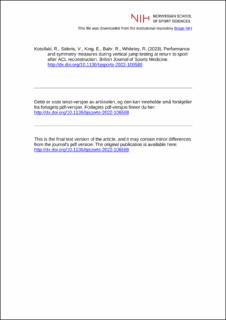| dc.contributor.author | Kotsifaki, Roula | |
| dc.contributor.author | Sideris, Vasileios | |
| dc.contributor.author | King, Enda | |
| dc.contributor.author | Bahr, Roald | |
| dc.contributor.author | Whiteley, Rod | |
| dc.date.accessioned | 2023-10-25T06:57:04Z | |
| dc.date.available | 2023-10-25T06:57:04Z | |
| dc.date.created | 2023-07-26T10:43:01Z | |
| dc.date.issued | 2023 | |
| dc.identifier.citation | British Journal of Sports Medicine. 2023, 57(20), 1304-1310. | en_US |
| dc.identifier.issn | 0306-3674 | |
| dc.identifier.uri | https://hdl.handle.net/11250/3098559 | |
| dc.description | I Brage finner du siste tekst-versjon av artikkelen, og den kan inneholde ubetydelige forskjeller fra forlagets pdf-versjon. Forlagets pdf-versjon finner du på bjsm.bmj.com / In Brage you'll find the final text version of the article, and it may contain insignificant differences from the journal's pdf version. The definitive version is available at bjsm.bmj.com | en_US |
| dc.description.abstract | Objective: Vertical jump tests are more sensitive in revealing asymmetries in performance metrics at the time of return to sport after anterior cruciate ligament (ACL) reconstruction (ACLR) than horizontal hop tests. However, it remains unclear which vertical tests (bilateral or unilateral) and which metrics (kinetics or performance) are most effective in informing the rehabilitation status and readiness for return to sport. We aimed to investigate the status of athletes during vertical jump testing at return to sport after ACLR. Methods: A dual force platform system was used to evaluate jumping performance of 126 recreational and professional athletes at the time of return to sport after ACLR, as well as 532 healthy control participants. Performance and kinetic metrics were collected during four jump tests: double-leg countermovement jump, single-leg countermovement jump, double-leg 30 cm drop jump and single-leg 15 cm drop jump. Between-limb and between-group differences were explored using mixed models analyses. Results: At the time of return to sport after ACLR, athletes still presented significant differences favouring the uninvolved side, particularly in the symmetry of the concentric impulse (p<0.001) in all jumps compared with the control group. Peak landing force asymmetry was greater in the ACLR group than the controls during the countermovement (p<0.001, MD=−11.6; 95% CI –15.4 to –7.9) and the double-leg drop jump (p=0.023, MD=−8.9; 95% CI –14.9 to –2.8). The eccentric impulse asymmetry was significantly greater (p=0.018, MD=−3.8; 95% CI −5.8 to –1.7) in the ACLR group during the single-leg drop jump only. Jump height was significantly lower (p<0001) in the ACLR group compared with controls in all tests except the double-leg drop jump. Conclusion: At the time of return to sport after ACLR, despite passing the traditional discharge criteria, athletes remained asymmetrical during all vertical jump tests, in the concentric (push-off) phase, during landing from bilateral jumps and for most performance metrics. Clinicians should aim to restore not only symmetry in ground reaction forces but also absolute performance metrics such as jump height, reactive strength index and contact times, to potentially reduce injury risk and improve overall athletic performance. | en_US |
| dc.language.iso | eng | en_US |
| dc.subject | anterior cruciate ligament | en_US |
| dc.subject | injury prevention | en_US |
| dc.subject | rehabilitation | en_US |
| dc.subject | sports | en_US |
| dc.title | Performance and symmetry measures during vertical jump testing at return to sport after ACL reconstruction | en_US |
| dc.title.alternative | Performance and symmetry measures during vertical jump testing at return to sport after ACL reconstruction | en_US |
| dc.type | Peer reviewed | en_US |
| dc.type | Journal article | en_US |
| dc.description.version | acceptedVersion | en_US |
| dc.source.pagenumber | 26 | en_US |
| dc.source.journal | British Journal of Sports Medicine | en_US |
| dc.identifier.doi | 10.1136/bjsports-2022-106588 | |
| dc.identifier.cristin | 2163614 | |
| dc.description.localcode | Institutt for idrettsmedisinske fag / Department of Sports Medicine | en_US |
| cristin.ispublished | true | |
| cristin.fulltext | postprint | |
| cristin.qualitycode | 2 | |
